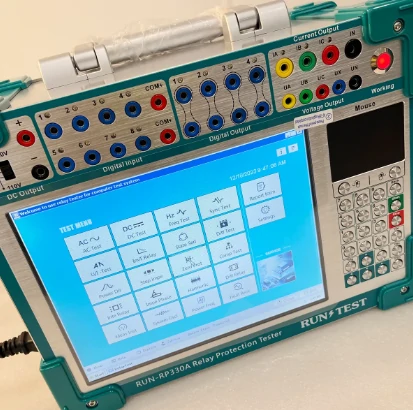What is a Relay Tester?
มิถุนายน 12, 2025
In the electrical systems domain, protecting the reliability and safety of the protective devices are the responsibilities of technical staffs. The relay tester is a primary tool which is used by technicians to validate the operability of the protective relays. The present article focuses on the purposes of the relay tester, the way it operates and the reasons it cannot be done without in keeping up electrical systems.
Understanding Relay Protection Tests
Relay protection tester is a specific appliance utilized to produce various types of faults in an electric system. The tester makes faults such as overcurrent, undervoltage, and short circuits appear and thus, is able to observe the behavior of the relay during the occurrence of these faults. By doing a relay protection test the engineer definitely knows that the other protective devices perform ok and that the relay is the device that best safeguards the electrical network.

Key Features of Relay Testers
Fault Simulation
This means that the tester really generates true fault currents and voltages to make sure that the relay operates as intended. This feature is dependable in the process of tests for verification of the relay.
Multi-phase Testing
Most electrical systems use three-phase power. These relay protection testers are capable of the multi-phase testing of relays that protect three-phase systems and can emulate all the expected states of these environments.
Accuracy and Precision
Preciseness is an absolutely crucial factor in voltage, current, and timing measurements. The relay testers are accountable for the reliable and exact replication of any faults occurring without the system tripping.
Compatibility with Various Relay Types
The most important feature that a relay tester should have is the ability to test the different types of relays. Such as distance, overcurrent, and differential relays.
Automation and Reporting
Technicians receive the reports in electronic format generated by the software. It managerially in their assessment of the devices help them to better understand the results.
Have any other questions? Welcome to contact us, we will serve you wholeheartedly!
Types of Tests Performed by Relay Testers
Functional Tests
The purpose of the functional tests is to see to it that relay behaves as anticipated during simulated faults. During the tests, engineers set the relay settings, from which they have to determine that the current or voltage limits are properly chosen or not.
Timing Tests
The timing tests are to be carried to make sure that the relay is sending the signal in the pre-set time when a fault occurs. This helps in keeping the system reliable and not allowing any damages to take place.
Burden Tests
Through burden tests, a relay can be seen as it reacts to different amounts of power it is subjected to. This enables engineers to understand the performance limits of the device and the characteristics of the system.
Coordination Tests
Test of coordination involves checking whether the functioning of a number of relays is concerted and at the same time not hampering each other.
Accuracy Tests
These tests are designed to establish how efficient the relay is in detecting the fault in a sensitive and reliable manner.
The RUN-RP330A: A Leading Relay Tester
One standout model in the market is the RUN-RP330A, a new three-phase relay protection tester. This device can test various AC and DC relays, including intermediate and self-holding relays. It features:
- Multi-phase Output: With 4-phase voltage and 3-phase current output, it can test both traditional and modern protection devices, making it versatile for different applications.
- User-friendly Interface: The classic Windows operation interface allows for easy navigation and operation, enhancing user experience.
- High-Performance Capabilities: The embedded industrial control computer and high-resolution display provide rich information, including the current working state and helpful tips.
- Advanced Testing Functions: The RUN-RP330A includes features like GPS synchronization testing and software self-calibration, ensuring high accuracy and reliability.
Conclusion
A relay tester is an indispensable tool for ensuring the reliability and safety of electrical systems. By simulating various fault conditions and assessing the performance of protective relays, these testers help prevent system failures and protect vital equipment. The RUN-RP330A exemplifies the advanced capabilities of modern relay protection testers, providing technicians with the tools they need to maintain and troubleshoot protective devices effectively.
For anyone involved in electrical maintenance and safety, understanding and utilizing a relay protection tester is essential. If you’re looking to enhance your testing capabilities, contact us now!
